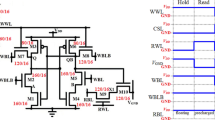Abstract
Static random access memories (SRAMs) are vital parts in digital circuits. The fast growth of battery-operated devices has caused methods for reducing power consumption in the memories to be important. SRAMs spend most of the time in hold state, and with their enlarging size, reducing static power becomes important. In this paper, two new low-voltage, 8- and 9-transistor cells with separate read/write path and the use of transistors with different threshold have been presented. These cells achieve a significant reduction in the static power and increase in read static noise margin (RSNM), and improvement in reading and writing speed, as compared to the conventional 7T and 9T cells. Static power of the first proposed cell is improved by 64.76 and 69.94% compared to the 7T cell and 9T cell, respectively. Also, this parameter for the second proposed cell is 66.87 and 71.74%, respectively. RSNM of the first proposed cell is improved by 121.66% compared to the 7T cell and 9T cell, and this parameter for the second proposed cell is 40.83%. In addition, the read time of two proposed cells is improved by almost 75% compared to that of the 9T cell. The write time of the first proposed cell is improved by 25.11 and 19.16% compared to that of the 7T cell and the 9T cell, respectively. This parameter for the second proposed cell is 31.74 and 26.26% compared to the 7T cell and 9T cell, respectively. In order to evaluate the performance of the proposed cells, simulations have been done in TSMC 130 nm CMOS technology with a supply voltage of 0.7 V.
















Similar content being viewed by others
References
Haghdad K, Parametric yield of VLSI systems under variability. Analysis and design solutions, PhD dissertation, Electrical and Computer Engineering, University of Waterloo, (2011)
C.B. Kushwah, S.K. Vishvakarma, D. Dwivedi, Single single-ended boost-less (SE-BL) 7T process tolerant SRAM design in sub-threshold regime for ultra-low-power applications. Circuits Syst. Signal Process. 35, 385–407 (2016)
K. Mehrabi, B. Ebrahimi, A. Afzali-Kusha, A robust and low power 7T SRAM cell design, in 18th CSI International Symposium on Computer Architecture and Digital Systems (CADS), 2015. https://doi.org/10.1109/CADS.2015.7377782
M. Moghaddam, S. Timarchi, M.H. Moaiyeri, M. Eshghi, An ultra-low-power 9T SRAM cell based on threshold voltage techniques. Circuits Syst. Signal Process. 35, 1437–1455 (2016)
A. Pal, Low-Power VLSI Circuits and Systems (Springer, New Delhi, 2015)
P. Pavan Kumar, R. Reddy, M. Lakshmi, Design of high speed and low power 4T SRAM cell, in International Journal of Scientific and Research Publications. 5, 2015
A. Pavlov, M. Sachdev, CMOS SRAM circuit design and parametric test in nano-scaled technologies (Springer, Dordrecht, 2008)
T. Pompl, R. Strasser, S. Drexl, M. Ostermayr, Comprehensive methodology for the statistic of SRAM V min. IEEE Trans. Device Mater. Reliab. 15, 289–297 (2015)
J. Rabaey, Low Power Design Essentials (Springer, Boston, 2009)
R. Saeidi, M. Sharifkhani, K. Hajsadeghi, A subthreshold symmetric SRAM cell with high read stability. IEEE Trans. Circuits Syst. II Express Briefs 61, 26–30 (2014)
E. Sicard, S. Bendhia, Basics of CMOS Cell Design, (McGraw-Hill Professional, 2007)
J. Singh, S. Mohanty, D. Pradhan, Robust SRAM Designs and Analysis (Springer, New York, 2013)
J. Singh, K. Ramakrishnan, S. Mookerjea, S. Datta, N. Vijaykrishnan, D. Pradhan, A novel Si-tunnel FET based SRAM design for ultra low-power 0.3 V VDD applications, in 15th Asia and South Pacific Design Automation Conference (ASP-DAC), 2010. https://doi.org/10.1109/ASPDAC.2010.5419897
A. Teman, L. Pergament, O. Cohen, A. Fish, A250mV8 kb 40 nm ultra-lowpower 9T supply feedback SRAM (SF-SRAM). IEEE J. Solid-State Circuits 46, 2713–2726 (2011)
Author information
Authors and Affiliations
Corresponding author
Rights and permissions
About this article
Cite this article
Naghizadeh, S., Gholami, M. Two Novel Ultra-Low-Power SRAM Cells with Separate Read and Write Path. Circuits Syst Signal Process 38, 287–303 (2019). https://doi.org/10.1007/s00034-018-0858-9
Received:
Revised:
Accepted:
Published:
Issue Date:
DOI: https://doi.org/10.1007/s00034-018-0858-9




